PUBLISHER: IoT Analytics GmbH | PRODUCT CODE: 1775080

PUBLISHER: IoT Analytics GmbH | PRODUCT CODE: 1775080
Industrial AI Market Report 2025-2030
A 400-page report on the current state of the industrial AI market, including detailed market sizing, forecasts, vendor market shares, key trends, use cases, adoption statistics, and more.
The "Industrial AI Market Report 2025-2030" is part of IoT Analytics' ongoing coverage of smart manufacturing and AI topics. The information presented in this report is based on the results of multiple surveys, secondary research as well as qualitative research i.e., interviews with experts and end users in the field. The document includes definitions for industrial AI and related topics (Edge AI, AI in robotics, Generative AI), market projections, adoption drivers, competitive landscapes, key trends and developments, and case studies.
This report is the third installment of our dedicated research coverage on industrial AI and related topics, including predictive maintenance, machine vision & robotics, digital twin, and edge AI.
PREVIEW
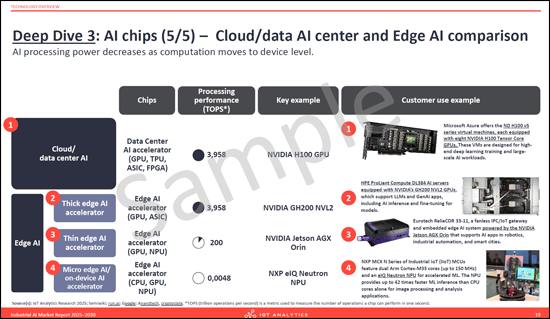
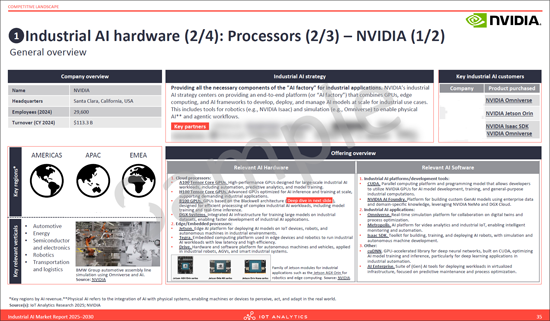
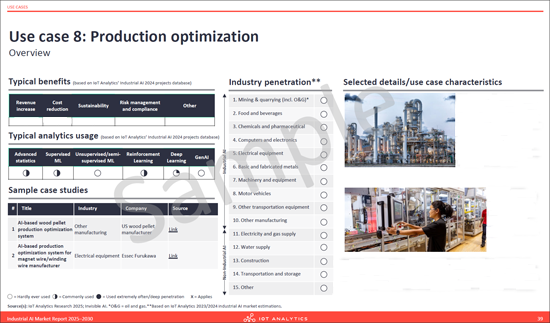
Questions answered:
- What is industrial AI (i.e., an industrial AI definition)?
- Which technologies are used for implementing industrial AI projects (including hardware and software deep-dive)?
- What is the current industrial AI market size and its forecast (by sub-markets, regions, technologies, industries)?
- Who are the key industrial AI vendors and what are their market shares?
- What are the 50 most common industrial AI use cases?
- What is the perspective of industrial AI end users? What are the factors that facilitate or limit adoption?
- How are selected manufacturers adopting industrial AI and what are the details of representative case studies?
- How do manufacturers adopt generative AI, edge AI and agentic AI?
- What are the key trends & challenges in industrial AI space?
PREVIEW
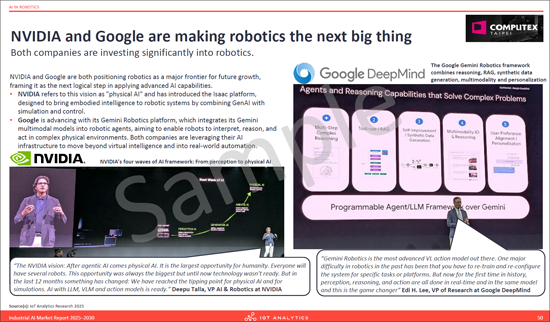
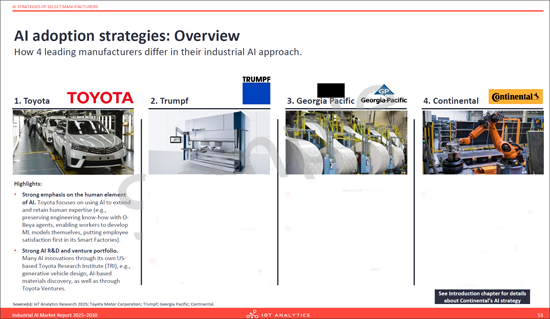
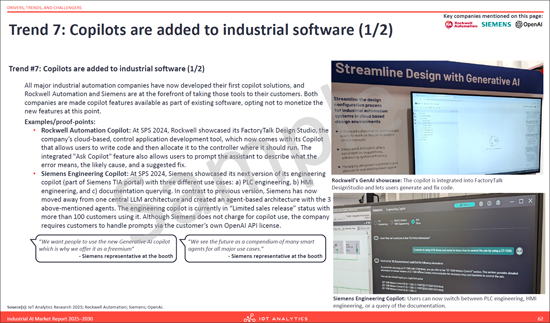
The main purpose of this document is to help our readers understand the current industrial AI landscape by defining, sizing and analyzing the market.
The Industrial AI Market Report 2025-2030
The global industrial AI market, a multi-billion dollar market in 2024, is forecast to experience significant double-digit growth through 2030. This report delivers market data and insights helping decisions makers navigate through the market landscape.
Report highlights:
- Market sizing & forecasts: A detailed market model and forecast to 2030, segmented by tech stack (hardware, software, services), AI type, industry, region, and by top five countries.
- Competitive landscape: In-depth analysis of the 15 largest vendors with market shares and 30+ upcoming companies.
- Use case & adoption analysis: Deep dive into 48 key use cases across 10 categories, enriched with end-user perspectives on adoption drivers and barriers.
- Strategic insights: A review of 21 key market trends and 6 challenges shaping the industrial AI space.
- Technology deep dives: Dedicated chapters providing in-depth analyses of Generative AI & Agentic AI, Edge AI, and AI in Robotics.
- In-depth studies: Features 6 detailed use case studies and 4 deep dives into the AI strategies of leading manufacturers.
The market report comes with the full market model data in EXCEL, a list of 670 industrial AI vendor in EXCEL, and a list of industrial AI projects (only team user and enterprise premium license).
What is industrial AI?
Definition of AI
AI (Artificial Intelligence) is defined as machine driven intelligent behavior that involves the ability to acquire and apply knowledge.
AI consists of an analytics (learning) and an outcome (action/decision/prediction) component:
- 1. Analytics corresponds to the data management processes and data science algorithms through which the device learns.
- 2. Outcome corresponds to the intelligent behavior, e.g., generating a decision, a prediction, or triggering an action.
Definition of industrial AI
Industrial AI is defined as the application of AI techniques to data generated by operational technology and engineering systems in asset-heavy sectors, optimizing industrial processes at any stage of the product and asset lifecycle.
- Operational technology and engineering systems: Control, monitoring, and design platforms that generate real-time and engineering data about physical assets (e.g., PLC, SCADA networks, sensors, CAD/CAE suites, and PLM tools)
- Asset-heavy sectors: Industries whose business relies on extensive physical infrastructure and equipment (e.g., discrete and process manufacturing, energy, chemicals, mining, and transportation)
- Industrial processes: Technical workflows that create, move, or sustain physical goods and assets (e.g., product design, manufacturing, maintenance, logistics, field service)
Companies mentioned:
A selection from 670 companies mentioned in the report.
|
|
|
Table of Contents
1. Executive Summary
- List of scope or coverage changes compared to the 2021 Industrial AI Market Report
- Chapter overview: Introduction
- Understanding AI: Definition and components
- Understanding AI: Key types and their differences
- Types of ML: Overview
- Types of ML: Examples
- Categories of AI: Overview
2. Introduction
- Types of analytics and role of AI: Overview
- Focus of this report: Industrial AI
- Understanding AI: Non-industrial vs. industrial AI solutions
- General and industrial AI timeline: from 1960 to 2024
- Industrial AI interest in context: Global searches for industrial AI
- Industrial AI interest in context: Vendors' quotes
- Industrial AI interest in context: Users' quotes
- Industrial AI interest in context: Role of AI for manufacturers
- Case in point: Industrial AI at a large automotive supplier
3. Technology overview
- Chapter overview: Technology overview
- The industrial AI implementation process - Process overview
- The industrial AI implementation process - Topics overview
- Deep dive 1: Common frameworks to determine AI business value
- Deep Dive 2: AI system requirements
- Deep Dive 3: AI chips
- Deep Dive 4: Build versus buying AI solutions
- Deep Dive 5: Data management
- Deep Dive 6: Ingest & prepare data
- Deep Dive 7: Develop & train models
- Deep Dive 8: ML Ops
4. Market size and outlook
- Chapter overview: Market size and outlook
- General drivers and inhibitors for the industrial AI market 2025
- Industrial AI market: What is included and what is not
- Global industrial AI market: Overall
- Data in perspective: What the average U.S. manufacturer spends on AI
- Global industrial AI market: By tech stack
- Global industrial AI market: By AI type
- Global industrial AI market: Training by hosting type
- Global industrial AI market: Inference by hosting type
- Global industrial AI market: By use case
- Global industrial AI market: By industry
- Discrete manufacturing industrial AI market: By ISIC code
- Hybrid manufacturing industrial AI market: By ISIC code
- Process manufacturing industrial AI market: By ISIC code
- Global extended industrial AI market: By region
- East Asia & Pacific industrial AI market: By country
- Europe & Central Asia industrial AI market: By country
- North America industrial AI market: By country
- Middle East & North Africa industrial AI market: By country
- Latin America & Caribbean industrial AI market: By country
- South Asia industrial AI market: By country
- Global industrial AI market: By top 10 countries and industry (2024)
- China industrial AI market: Overall
- China industrial AI market: By tech stack
- China industrial AI market: By industry
- China industrial AI market: By use case
- USA industrial AI market: Overall
- USA industrial AI market: By tech stack
- USA industrial AI market: By industry
- USA industrial AI market: By use case
- Germany industrial AI market: Overall
- Germany industrial AI market: By tech stack
- Germany industrial AI market: By industry
- Germany industrial AI market: By use case
- Japan industrial AI market: Overall
- Japan industrial AI market: By tech stack
- Japan industrial AI market: By industry
- Japan industrial AI market: By use case
- South Korea industrial AI market: Overall
- South Korea industrial AI market: By tech stack
- South Korea industrial AI market: By industry
- South Korea industrial AI market: By use case
5. Competitive landscape
- Chapter overview: Competitive landscape
- Company landscape: Vendor classifications
- Methodology: How individual companies were analyzed
- Example: How this report accounts for NVIDIA 2024 revenues
- Company landscape: Company database
- The 15 largest industrial AI vendors: Overview
- Competitive landscape 2024: Market share overview by tech stack
- 1. Industrial AI hardware: Processors - Market share
- Industrial AI hardware: Processors - NVIDIA
- Industrial AI hardware: Computing systems - Market share
- 2. Industrial AI software: How to think about the comp. landscape
- Industrial AI software: Platforms - Market share
- Industrial AI software: Platforms - Microsoft
- Industrial AI software: Platforms - AWS
- Industrial AI software: Platforms - Upcoming companies
- Industrial AI software: AI-native Applications - Vision/Inspection
- Industrial AI software: AI-native Applications - Maintenance
- Industrial AI software: AI-native Applications - Others
- Industrial AI software: AI-native Applications - Value prop.
- Industrial AI software: AI-native Apps - Value prop.
- Industrial AI software: AI-native Applications - Value prop.
- 3. Industrial AI services: Market share
- Industrial AI services: Accenture
- Industrial AI services: Accenture - AI agent showcase
- Industrial AI services: Capgemini
- AI Libraries
6. Use cases
- Chapter overview: Use cases
- Main industrial AI use cases: Share of industrial AI market 2024
- Main industrial AI use cases: Definitions
- Use case 1: Automated optical inspection
- Use case 1: Automated optical inspection - Case study
- Use case 2: Predictive maintenance of single assets
- Use case 2: Predictive maintenance of single assets - Case study
- Use case 3: Autonomous machines/robots
- Use case 3: Autonomous machines/robots - Case study
- Use case 4: Cybersecurity threat detection
- Use case 5: Predictive maintenance of complete systems/plants
- Use case 6: Surveillance and physical threat detection
- Use case 6: Surveillance and physical threat detection - Case study
- Use case 7: Automated non-optical fault detection
- Use case 8: Production optimization
- Use case 9: Route optimization and scheduling
- Use case 9: Route optimization and scheduling - Case study
- Use case 10: Autonomous logistics systems
- Use case 10: Autonomous logistics systems (ALSs) - Case study
- Other notable case studies
- Other notable case studies: Focus - Generative AI
7. Generative AI and Agentic AI
- Chapter overview: Generative AI and Agentic AI
- This chapter looks at GenAI & agentic AI through 5 lenses
- Analysis of 530 GenAI projects: Overview
- Analysis of 530 GenAI projects: By Department
- Analysis of 530 GenAI projects: By department and activity
- Analysis of 530 GenAI projects: By industry
- Analysis of 530 GenAI projects: By industry and department
- Analysis of 530 GenAI projects: Crossing the chasm
- How to monetize GenAI applications
- Industrial agentic AI: Overview
- Industrial agentic AI: Model context protocol (MCP) - Overview
- Industrial agentic AI: Model context protocol (MCP) - Adoption
- Industrial agentic AI: MCP - Example
- Industrial agentic AI: Future vision - 1. Critical manufacturing
- Industrial agentic AI: Future vision - 2. Siemens
- Industrial agentic AI: Future vision - 3. Mendix
- Industrial agentic AI: Agentic workflow - Example
- Industrial GenAI & agentic AI trend
- Industrial GenAI/agentic AI solutions - Overview
- Industrial GenAI/agentic AI solutions - #2 Engineering Orchestrator
- Industrial GenAI/agentic AI solutions - Microsoft's AI agents
- Industrial GenAI/agentic AI solutions - Siemens IFM
- Industrial GenAI/agentic AI solutions - ABB Genix Copilot
8. Edge AI
- Chapter overview: Edge AI
- Edge AI: Overview
- What is edge AI?
- Why edge AI matters?: Reasons for AI coming to the edge
- Edge AI architectures: Overview
- Edge AI architectures: Example
- Edge AI architectures: Stages of edge AI processing
- Key edge AI technologies: Overview
- Key edge AI technologies: 1. AI accelerators at the micro edge
- Key edge AI technologies: 2. AI accelerators at the thin edge
- Key edge AI technologies: 3. Edge AI development platforms
- Key edge AI technologies: 4. Tiny Machine Learning
- Key edge AI technologies: 5. Edge learning
- Key edge AI technologies: 6. Vision-language models (VLM)
- Key edge AI technologies: 7. Federated learning
- Industrial Edge AI Trend
9. AI in robotics
- Chapter overview: AI in robotics
- NVIDIA and Google are making robotics the next big thing
- AI foundation models bring generalization and autonomy to robots
- Overview: Key AI topics for industrial robot OEMs
- Key robot AI use cases
- AI setup of leading robot OEMs
- Trend
- AI adoption strategies: Overview
10. AI strategies of select manufacturers
- 1. Toyota Motor Corporation: Strategy overview
- Toyota Motor Corporation: Toyota Research Institute
- Toyota Motor Corporation: Overall manufacturing vision
- Toyota Motor Corporation: Overall manufact. vision - AI role
- Toyota Motor Corporation: Toyota Ventures portfolio
- Toyota Motor Corporation: Key AI partnerships & investments
- 2. Trumpf: Strategy overview
- Trumpf: Venture investments with a focus on AI
- Trumpf: Key AI partnerships & investments
- Trumpf: Customer-facing AI applications developed by Trumpf
- 3. Georgia-Pacific: Strategy overview
- Georgia-Pacific: AI-implementation projects
- Georgia-Pacific: AI-implementation projects - Key results
11. End user insights
- Chapter overview: End user insights
- End-user insights: Overview of the 4 surveys
- Industrial AI Survey #1: Key Insights
- Adoption status of AI in key industrial applications
- Importance of various industrial AI use cases going forward
- Future training and execution (inference) locations for industrial AI
- Industrial AI Survey #2: Key Insights
- Value of AI for troubleshooting/maintenance: Overview
- Value of AI for troubleshooting/maintenance: By industry
- Industrial AI Survey #3: Key Insights
- Industrial AI adoption and plans to expand its use
- Benefits of industrial AI
- Benefits of industrial AI: Benefits for workers
- Non-AI compatible equipment
- AI challenges and corresponding mitigation actions
- Industrial AI Survey #4: Key Insights
- Industrial AI copilots vs. AI agents
- Adoption of industrial AI by application area
- Type of industrial AI deployed
- Barriers for industrial AI adoption
- Plans to address the industrial AI skills gap
- Investments plans for industrial AI by application area
12. Drivers, trends and challenges
- Trend
- Challenge
- Other key challenges
13. Methodology and market definitions
- Research methodology
- Definitions of AI types
- Definitions of the tech stack
- Industry mappings to ISIC codes
- Survey questions
14. About IoT Analytics
- About IoT Analytics
- Other publications by IoT Analytics
- Information and contact




